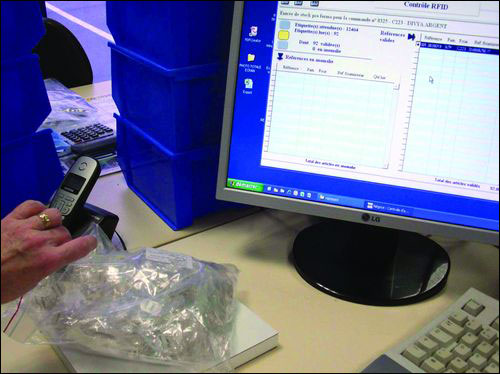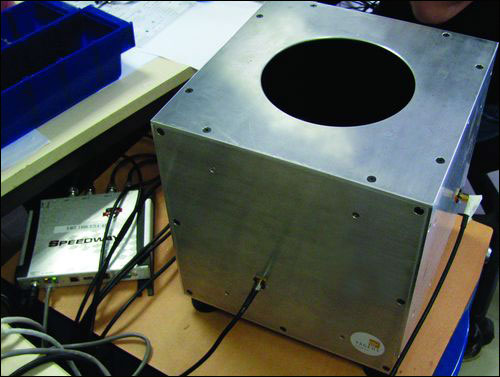Jan 03, 2011French jewelry retailer Cleor reports that since it rolling out an RFID system at its 50 stores, an inventory check conducted at each site takes only several hours to accomplish, instead of the several days it had taken prior to the technology's adoption. The solution was installed over the course of eight months, initially at Cleor's Paris-area distribution center and at 10 stores, and ultimately, at the company's remaining 40 retail locations.
Cleor has been selling jewelry for more than a decade, at locations in Paris and in other cities in northern and western France. By the end of 2011, the company intends to have added 10 additional stores. Currently, the firm sells approximately one million pieces of jewelry annually. Cleor's DC receives bags of jewelry from its suppliers in Europe and Asia. Each bag contains up to 100 pieces of jewelry, and the DC's staff must unpack the bags and match every item against the order sent by the jeweler to that bag's supplier. To do this, a worker must scan a bar-coded label on each item, thereby recording its receipt in the company's back-end management system.

The items may then be put into storage, or some (typically 20 to 30) may be placed into smaller bags for shipment to individual stores. When a store receives a shipment, employees there scan each piece's bar code to verify when that item has been received, and again periodically during store inventory checks, to determine which products are in the stock room or on the sales floor. The bar-coded labels are small, however, and require a considerable amount of handling of the jewelry item itself by staff members in order to ensure that every bar-code label could be scanned. The process was time-consuming for both receiving and inventory management, the company reports, and mistakes could be made if a bar code, for example, was illegible or inadvertently not scanned.
When Cleor sought to replace that system with one involving radio frequency identification, it wanted a solution that could be installed easily and not disrupt its existing management processes. The resulting system includes custom reader antennas provided by Tageos, RFID readers from Impinj and RFID-enabled handheld computers supplied by Psion Teklogix.

The solution, installed by Frequentiel, needed to be integrated with Cleor's existing enterprise resource planning (ERP) software so that none of the store's existing management processes would need to be changed. It also required hardware that could read very small RFID labels at the DC and the stores, while ensuring that only one item's tag would be read at a time during inventory checks at the stores, so that workers could compare the product with its picture, thereby verifying that no tag from one item had been switched with that of another. Frequentiel worked with Tageos, which developed the reader antennas for the Impinj Speedway Revolution readers, and the Psion Teklogix handhelds with built-in Impinj Indy reader chips, says Scot Stelter, Impinj's senior director of product marketing. The system also employs six Toshiba RFID label printer-encoders.
Cleor's DC uses its six label printer-encoders to write a unique identifier to each ultrahigh-frequency (UHF) EPC Gen 2 passive RFID label, and prints a bar-coded version of that same ID number on the label. Bar codes are provided for redundancy, should an RFID read ever fail. The DC then sends those RFID labels to participating suppliers. Currently, approximately 65 percent of the company's suppliers tag the products they send to Cleor; the retailer hopes that number will eventually rise to 100 percent. When the DC receives a bag of jewelry from a participating supplier, a worker simply places it into the RFID Cube. Frequentiel software then links the tag ID of each jewelry item in the bag to that product's stock-keeping unit (SKU), description and photo, all stored in Cleor's management software, provided by Odeis.

When the distribution center receives a bag of non-tagged jewelry, the staff attaches an RFID label to each item, utilizing the same Toshiba devices to encode and print the labels, and to link each tag's ID number to the SKU and other product information in the Odeis system. The newly tagged items are then put back into their bag and placed in the Cube. Once the Cube reads an item's tag, that product's status is updated in the management software, indicating it has been received at the DC.
When one of the stores places an order, DC workers retrieve the jewelry items necessary to fill that order, placing them into small bags. The bags are then placed on an RFID mat approximately 1 square foot in size, with an embedded Tageos RFID reader antenna wired to an Impinj reader. (The team members opted against using another Cube for this particular operation because the small bags contain fewer RFID tags, making the mat a suitable and less-expensive choice.) When the mat reads the tags, the Frequentiel software captures the ID numbers and again links them to the SKUs and other identifiers in the Odeis software, which then confirms the order's accuracy and updates those items' status as having been shipped.
At each store, the same type of Tageos mat antenna and Impinj reader are used for receiving new products from the DC. Bags are placed on the mat, the tag reads are forwarded to the Odeis system, indicating they have been received at the store, and the goods are then placed in display cases. To complete inventory checks of the items within the cases, the staff utilizes a Psion Teklogix handheld computer with a paddle antenna shaped similarly to a large toothbrush, its read range set at just 5 centimeters (2 inches) to ensure that only one tag is read at a time. As employees hold the paddle antenna over each tag, the handheld's screen displays a description and picture of the item linked to that tag's ID number, so that they can then verify that the tag belongs with that particular item. The reader software stores each tag ID number that is read as well. After completing the inventory process, the staff members then plug the reader into the PC, and the list of inventory is uploaded to the Odeis software. If any items are missing, they can then be highlighted on the PC screen.
At the point of sale, as an item is being purchased, it is placed on the same mat antenna, and that product's tag ID number is captured and forwarded to the back-end system, thereby indicating it has been sold. The tag is removed from the jewelry before a customer leaves the store, and is then discarded.
While the RFID system saves labor hours, Repellin says, the greatest value for Cleor was improved accuracy. The solution ensures that each order's accuracy is automatically verified before it leaves the distribution center, after which the tags are read once more at the store, allowing confirmation that the order was received in full. All of this information is then stored in the back-end system. According to Cleor, this process reduces errors in shipping and receiving.
Aurélien Senechal, Cleor's managing director, comments via e-mail that he is happy with the system. "This innovative RFID solution revolutionizes the business of jewelry," he states.
According to Stelter, the unusually quick deployment of Cleor's RFID system is an indication of a trend in the RFID market. "Projects are moving faster these days," he says, adding, "Integrators are smarter and products are more plug and play" than they were even a year ago. Retailers, he indicates, are moving toward solutions that allow the use of handheld readers to collect inventory data, rather than having to wait for technology using fixed readers to enable items to be located in real time, or to capture items as they pass through portals at the store. Although such applications are currently in place at some stores, he notes, most retailers find such a system to be too cumbersome or expensive.


